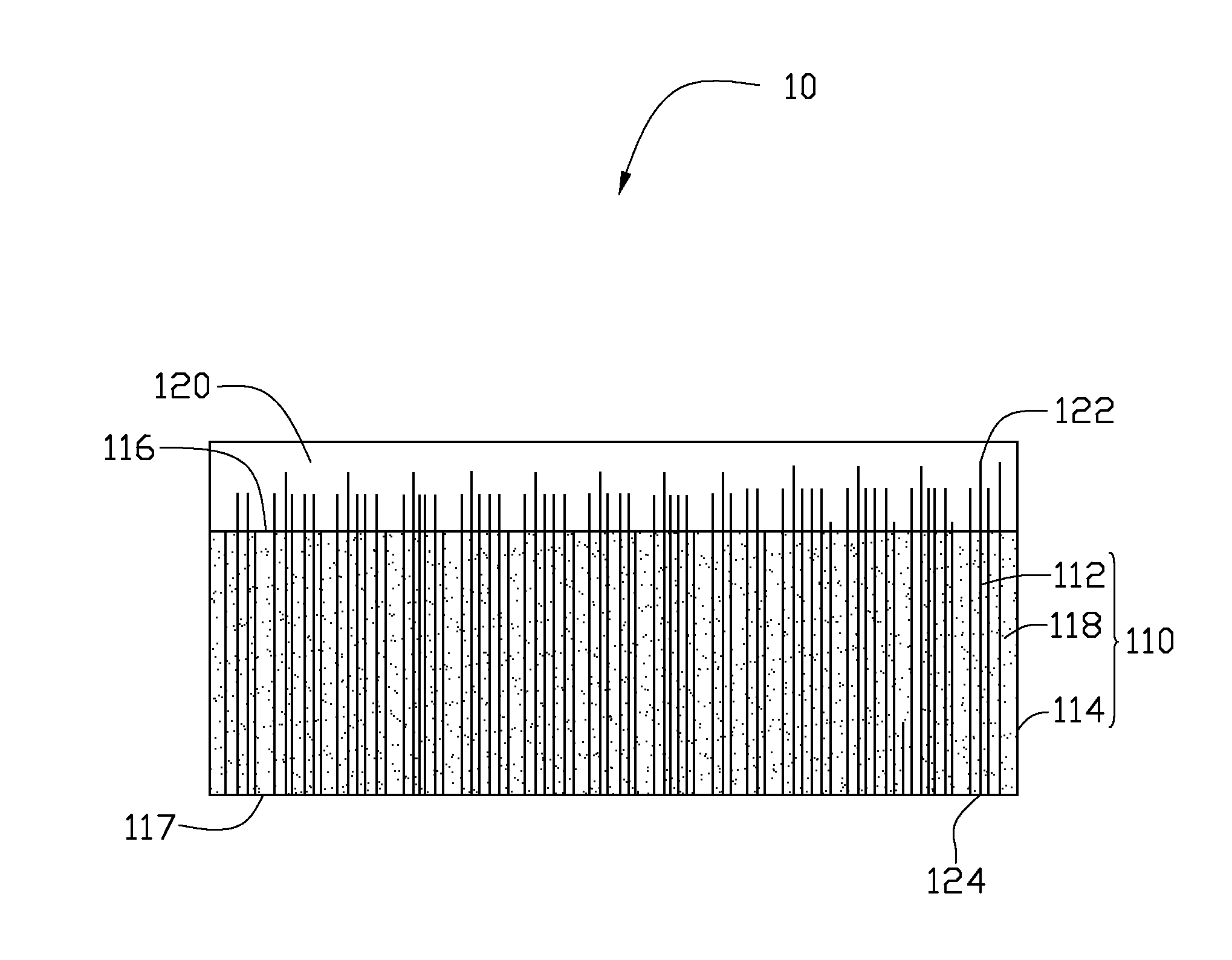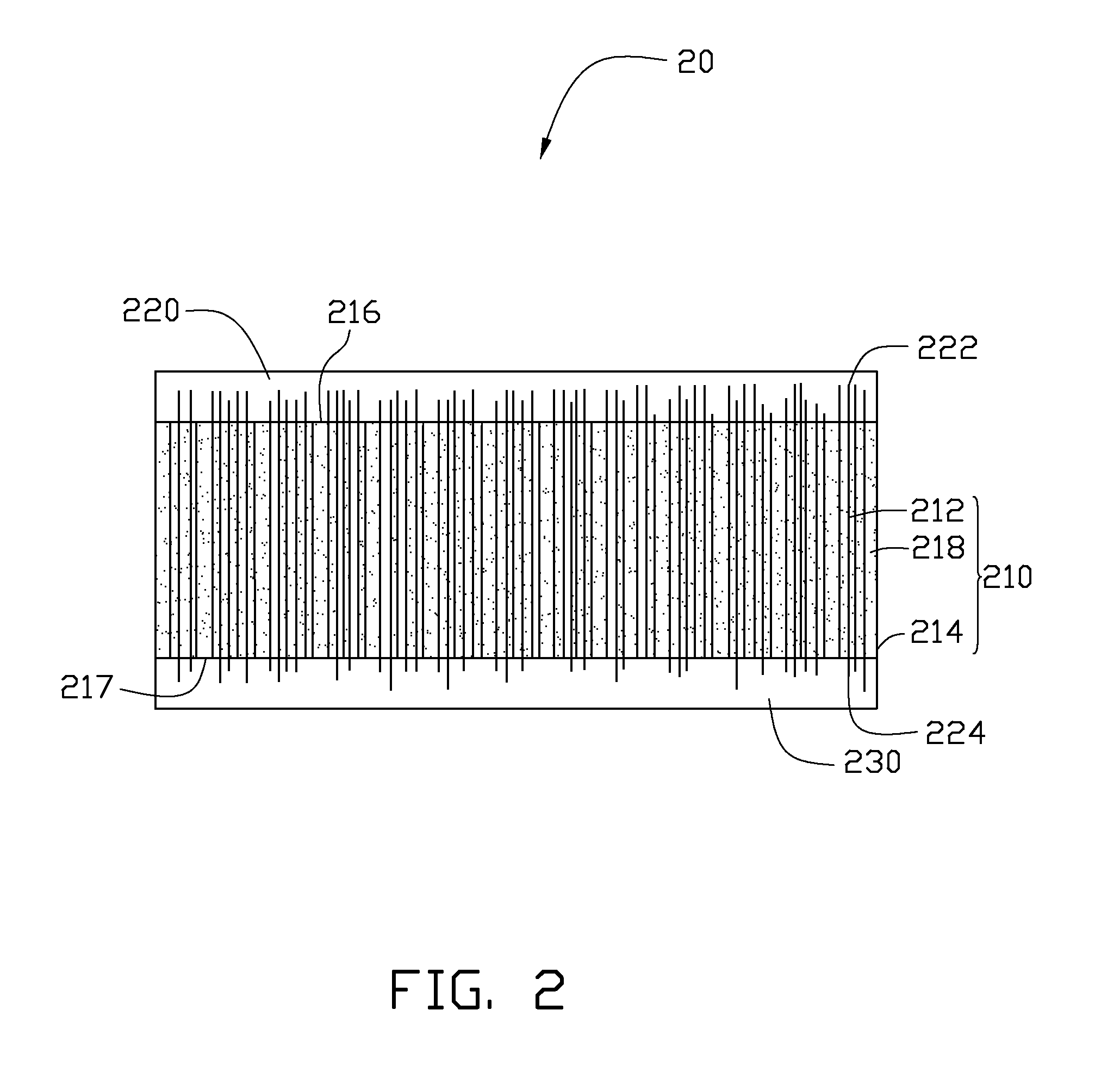Heat dissipation structure and heat dissipation system adopting the same
a heat dissipation structure and heat dissipation system technology, applied in lighting and heating apparatus, modifications by conduction heat transfer, semiconductor/solid-state device details, etc., can solve the problem of affecting the heat dissipation efficiency of the thermal interface material
- Summary
- Abstract
- Description
- Claims
- Application Information
AI Technical Summary
Benefits of technology
Problems solved by technology
Method used
Image
Examples
first embodiment
[0017]Referring to FIG. 1, a heat dissipation structure 10 includes a thermal interface material 110 and a transition layer 120. The thermal interface material 110 has a first surface 116 and a second surface 117 opposite to the first surface 116. The transition layer 120 is positioned on the first surface 116 of the thermal interface material 110.
[0018]The thermal interface material 110 includes a matrix 114 and a plurality of carbon nanotubes 112 dispersed in the matrix 114. A material of the matrix 114 includes a phase change material, such as resin material, thermal plastic, rubber, silicone, and a mixture thereof. The resin includes epoxy resin, acrylic resin or silicone resin. In one embodiment, the material of the matrix 114 is silicon elastomer kit.
[0019]The plurality of carbon nanotubes 112 can be substantially parallel to each other, and substantially perpendicular to the first surface 116 of the thermal interface material 110. One end of each of the plurality of carbon na...
second embodiment
[0033]Referring to FIG. 2, a heat dissipation structure 20 includes a thermal interface material 210 and a first transition layer 220 and a second transition layer 230. The thermal interface material 210 includes a first surface 216 and a second surface 217 opposite to the first surface 216. The first transition layer 220 is positioned on the first surface 216 of the thermal interface material 210. The second transition layer 230 is positioned on the second surface 217 of the thermal interface material 210.
[0034]The thermal interface material 210 includes a matrix 214, a plurality of carbon nanotubes 212 and a plurality of thermal conductive particles 218. The plurality of carbon nanotubes 212 and the plurality of thermal conductive particles 218 are dispersed in the matrix 214. The plurality of carbon nanotubes 212 is substantially perpendicular to the first surface 216 of the thermal interface material 210. The plurality of carbon nanotubes 212 includes first ends 222 and second e...
third embodiment
[0039]Referring to FIG. 3, a heat dissipation structure 30 includes a thermal interface material 310 and a first transition layer 320 and a second transition layer 330. The thermal interface material 310 includes a first surface 316 and a second surface 317 opposite to the first surface 316. The first transition layer 320 is positioned on the first surface 316 of the thermal interface material 310. The second transition layer 330 is positioned on the second surface 317 of the thermal interface material 310.
[0040]The thermal interface material 310 includes a matrix 314, a plurality of carbon nanotubes 312 and a plurality of thermal conductive particles 318. The plurality of carbon nanotubes 312 and the plurality of thermal conductive particles 318 are dispersed in the matrix 314. The plurality of carbon nanotubes 312 is substantially perpendicular to the first surface 316 of the thermal interface material 310. The plurality of carbon nanotubes 312 includes first ends 322 and second e...
PUM
| Property | Measurement | Unit |
|---|---|---|
| thickness | aaaaa | aaaaa |
| thickness | aaaaa | aaaaa |
| mass percent | aaaaa | aaaaa |
Abstract
Description
Claims
Application Information
 Login to View More
Login to View More - R&D
- Intellectual Property
- Life Sciences
- Materials
- Tech Scout
- Unparalleled Data Quality
- Higher Quality Content
- 60% Fewer Hallucinations
Browse by: Latest US Patents, China's latest patents, Technical Efficacy Thesaurus, Application Domain, Technology Topic, Popular Technical Reports.
© 2025 PatSnap. All rights reserved.Legal|Privacy policy|Modern Slavery Act Transparency Statement|Sitemap|About US| Contact US: help@patsnap.com



